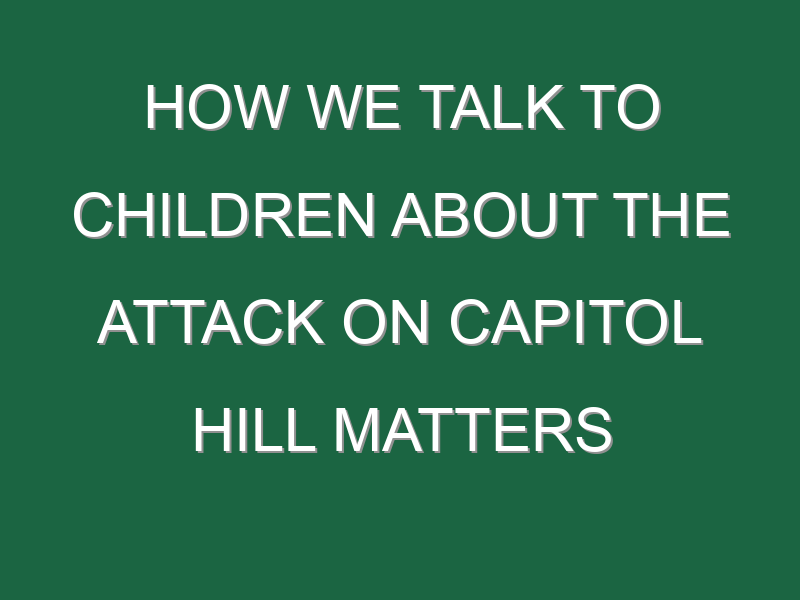On January 6, 2021, I sat in front of my television in awe and fear as I watched a mob of mostly white men storm the Capitol building, waving Confederate flags and proclaiming victory over our government. As a gay man of color with two Black children, I was afraid. My mind then quickly vaulted to my professional role as director of equity and student supports for the Lexington Public Schools just outside Boston. My position provides support to historically marginalized and silenced groups in our schools, and I knew that the news out of Washington had the potential to be particularly traumatic for certain populations, including our students, staff, and families of color. How could we help our staff create safe spaces to process all of this the following morning?
I am lucky to work with an excellent group of school leaders, many of whom dropped everything to join me in crafting clear messaging for our staff that built on our previous work building their capacity to engage in difficult conversations with students. I often tell our staff that they may not feel comfortable, but they are ready to have these conversations, even with our youngest students.
Working collaboratively with administrators from across the district, we created the following guidance for our staff. As we shared the suggestions more widely, we quickly came to see the value of these points for parents who wanted to engage in these conversations with their children, and department leaders reached out with brilliant thinking on how they could adapt these ideas for processing the events with their staff.
Name what happened
Particularly with older students, explicitly name how what happened differs from peaceful protest and the exercise of free speech. These events were violent and unlawful, and in comparison to how other protests have been handled historically, they were clearly rooted in a system of racism and white supremacy. While some in our community may agree with the ideology of those who incited, supported, and enacted violence, this is not a time for a discussion of “both sides.” There is only right and wrong. Acknowledge this was a traumatic event, and challenge those who think otherwise to reflect on why they feel that way.
Follow your students’ lead
Especially with younger children, begin with questions like, “Did anyone hear about the news?” or “What do you know about what happened in Washington, D.C.?” before clarifying misinformation. If students seem anxious to process, give them space to do so if you feel ready. If they seem anxious to focus on other topics, name that (“It doesn’t seem like many of you want to discuss this…”) and then move on. Since emotions are likely still raw at this point, ensure students who differ from their peers have an alternative option, like allowing someone who wants to discuss the topic further to meet with a counselor or a child who doesn’t want to engage in a class discussion the chance to opt out (“For those of you who for any reason don’t feel ready to have this conversation right now, here are your options…”).
Be aware of your own reactions to the events
Staff and other adults need to pay careful attention to our own reactions to events. Children of all ages take their cues from the adults around them. Staff members should seek support for themselves if needed. There is no shame in asking for help from a colleague.
Make time and space
It is appropriate and necessary to create time and space to process troubling events. When beginning conversations with students, it can be helpful to establish some parameters, reminding everyone of previously established norms for difficult conversations, stating clear expectations about how to disengage when overwhelmed, and previewing content (“We’re going to talk now about national events, and then move through our day. We will be back at the end of the day to check in if anyone needs it. Should you need more support during the day we are here to support you.”) If you don’t feel ready to lead a conversation about these events, you should still address it in some way. Silence is not an act of neutrality; it can negate the validity of children’s feelings. Consider using language like, “Yesterday’s news was really difficult to watch, and I’m still processing it myself. I’m not feeling ready to have this conversation yet, but if you are, here’s where you can go…” Remember it’s okay to say, “I don’t know.” Sometimes what students need the most is knowing that you are listening and that you care.
Think heart, not head
Sometimes a cerebral and logical discussion of a traumatic event can be counterproductive, especially if it occurs too soon after the event. It can be helpful to explicitly remind those taking a more academic rhetorical stance that, for some, it is not possible to avoid challenging emotions like fear and grief in discussing these events.
Help identify coping strategies
Give students concrete ideas for working through their thoughts and emotions and time to do them, like talking to a trusted adult, taking a break from news and social media exposure, or even taking a walk, drawing, or playing a game. Help them accept non-closure, both because the event is evolving hourly and because it is representative of larger systems of oppression that have been operating in our country for generations.
Johnny Cole is Director of Equity & Student Supports at Lexington Public Schools and a proud member of an interracial family, built with love with his husband and their two adopted children. Prior to becoming an administrator, he spent more than a dozen years as a high school English teacher.
More opinion from Fortune:
- Why the U.S. needs a national climate investment fund
- Why “soft robots” have NASA, doctors, and tech whizzes so excited
- 20 things that went strangely, wonderfully right in 2020
- Marketers can’t predict what you’ll buy—even if they use A.I.
- Why the PPP still falls short for small businesses




